1 Highest and Best Use Decisions Wayne Foss,



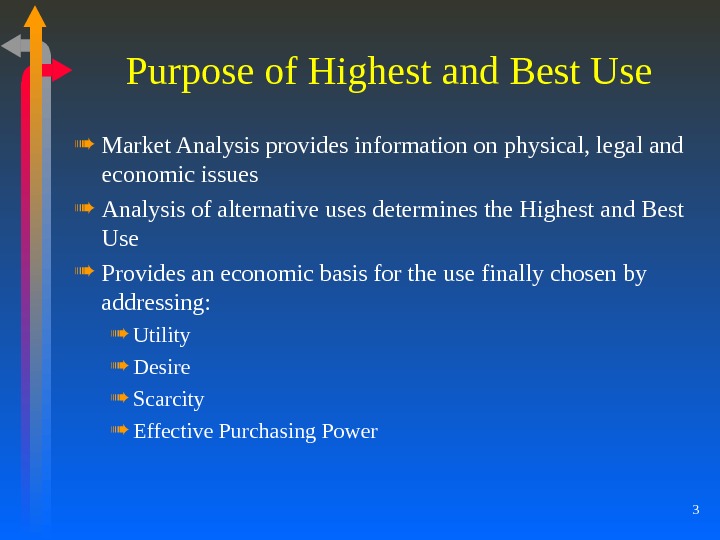
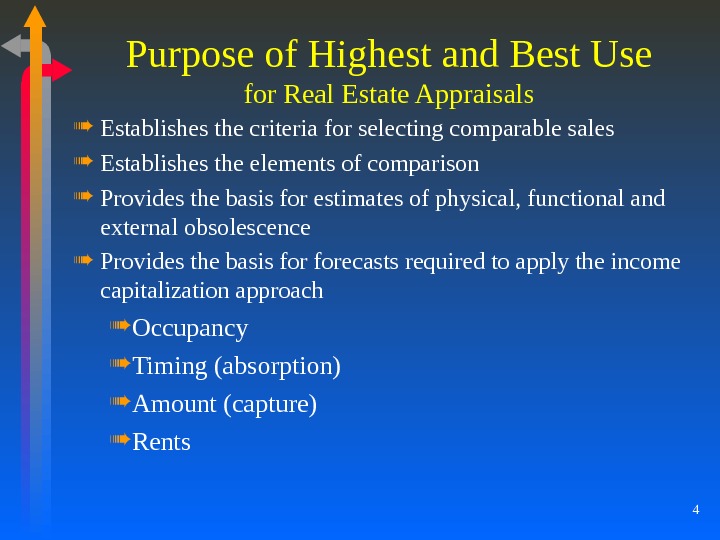

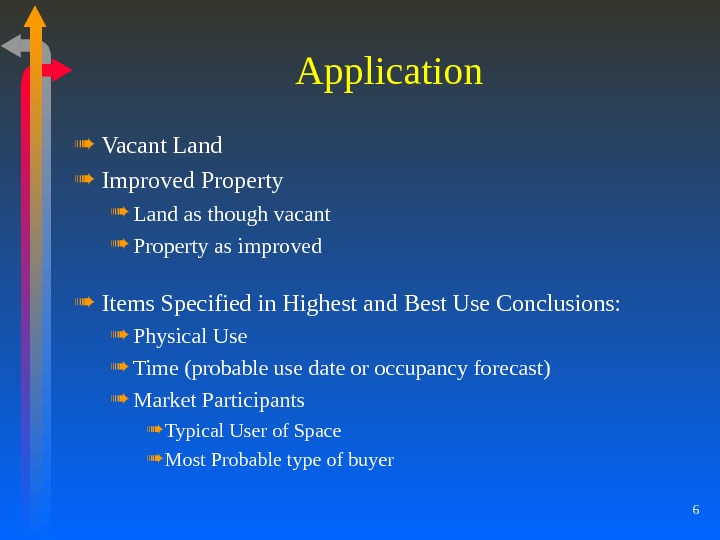

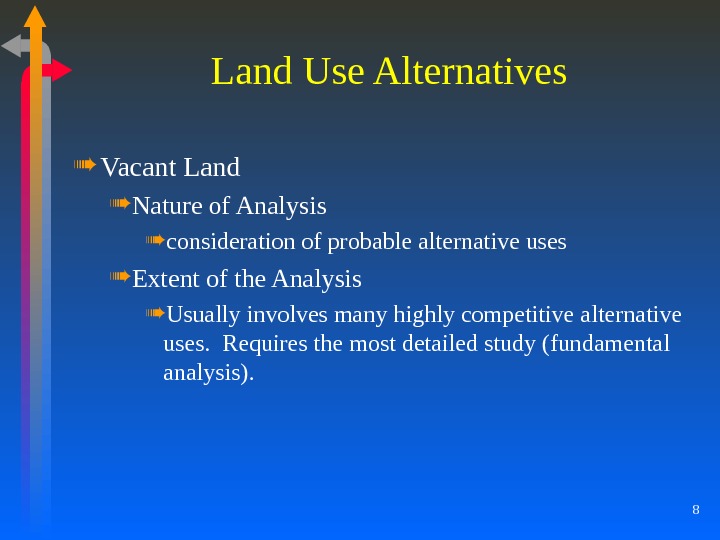
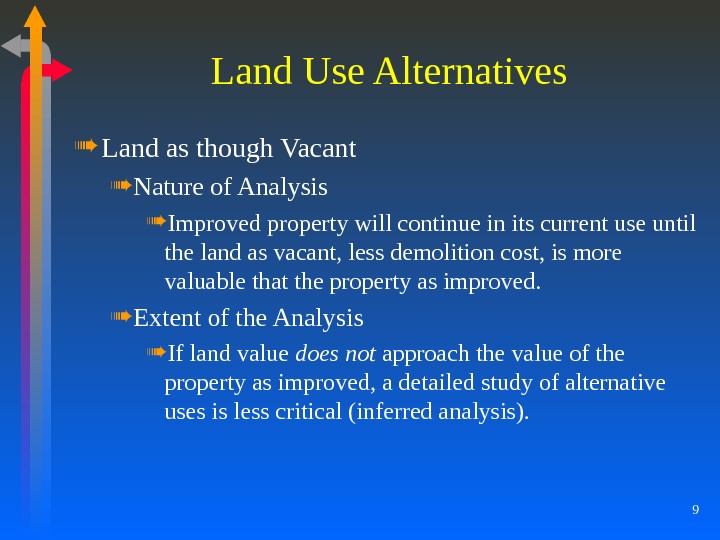

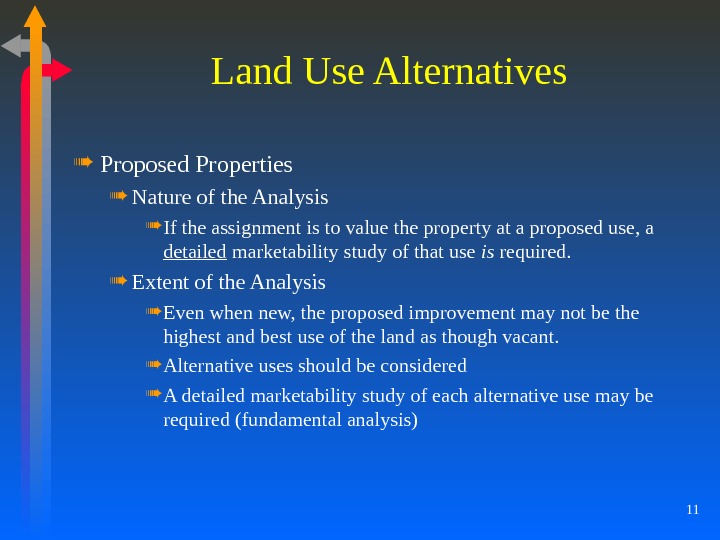



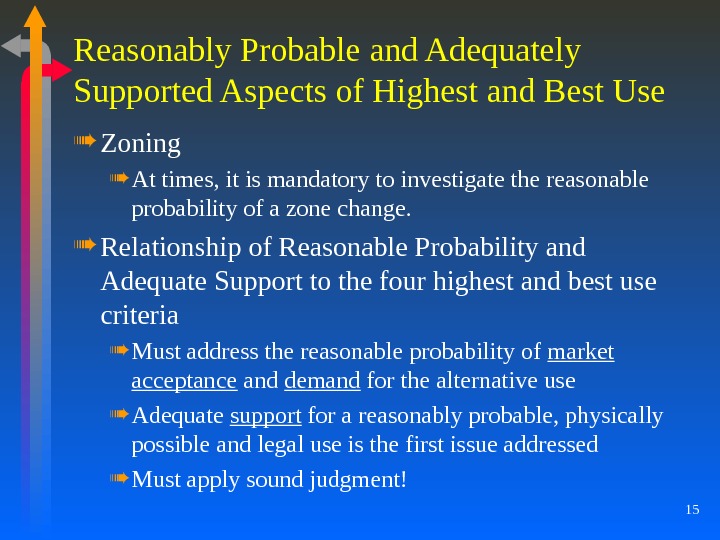
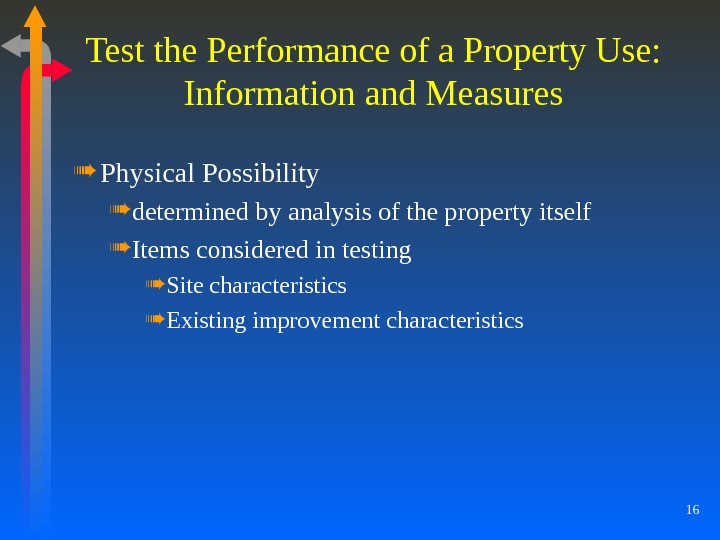
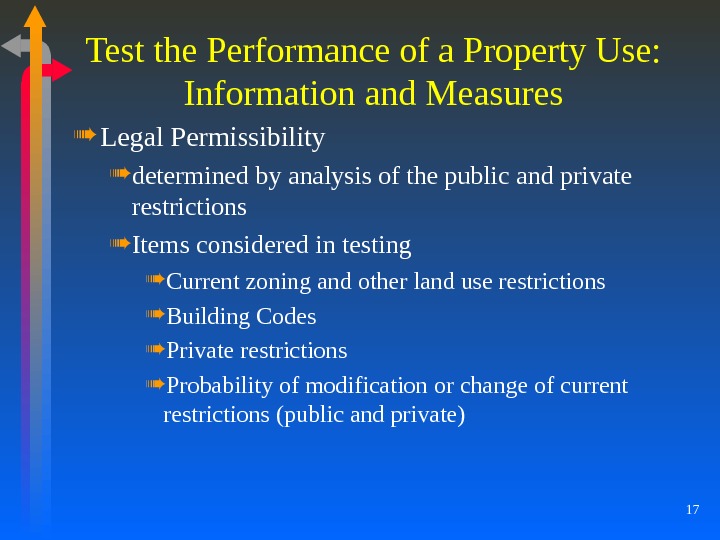
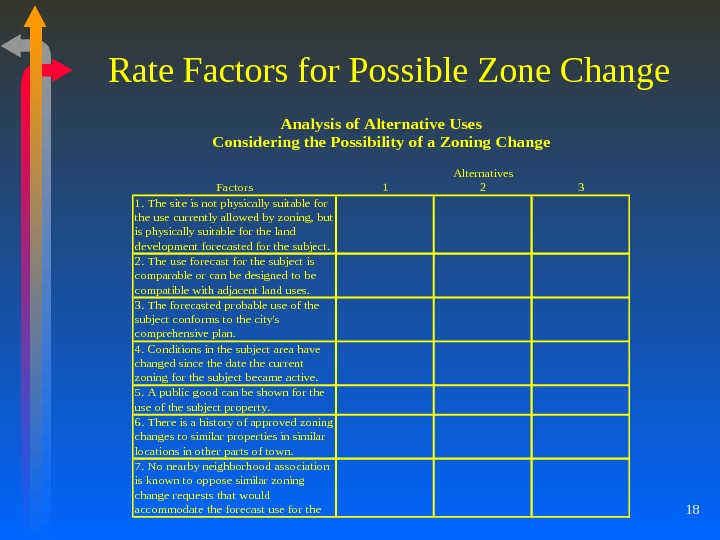
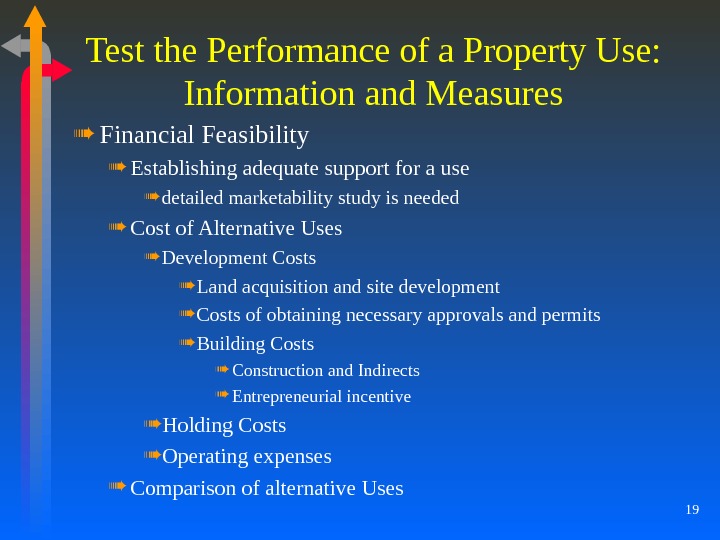
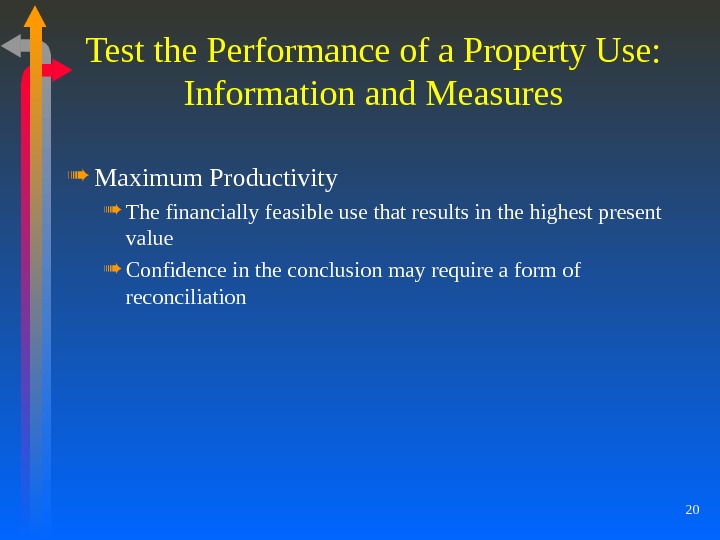

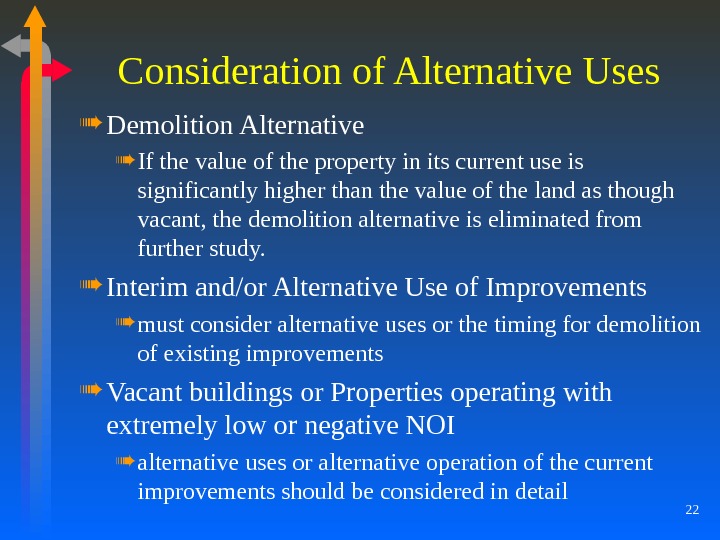
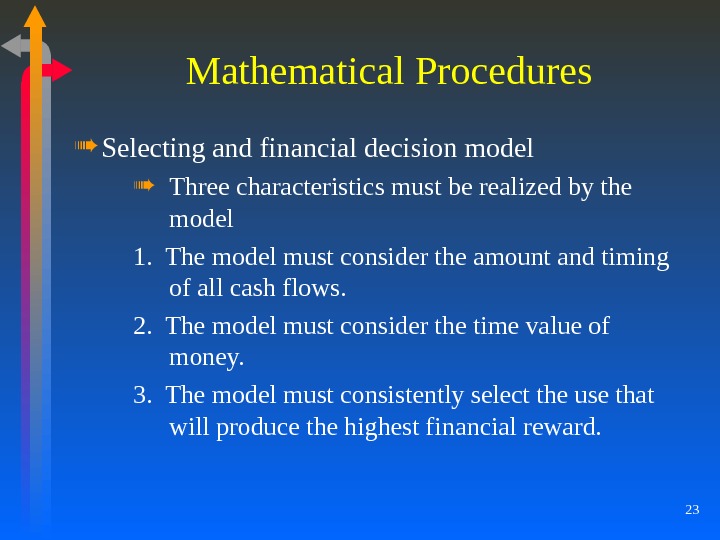
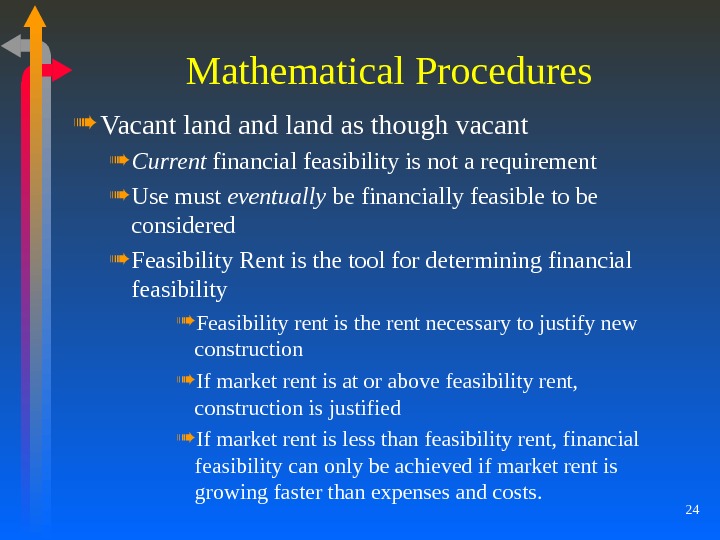
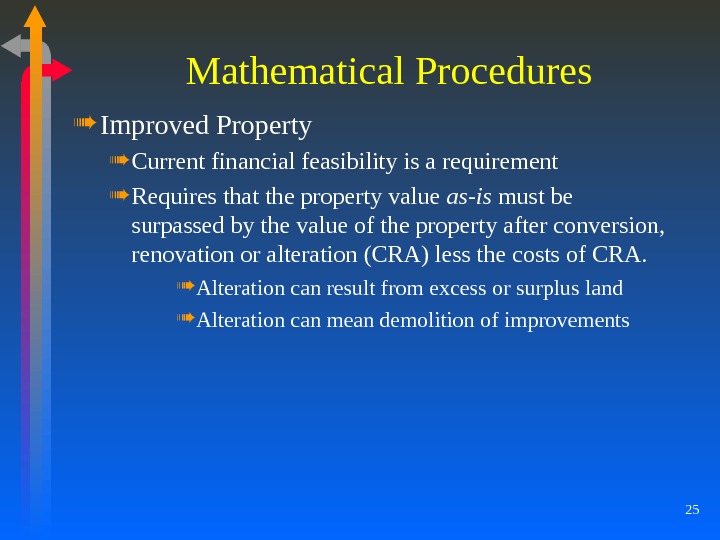
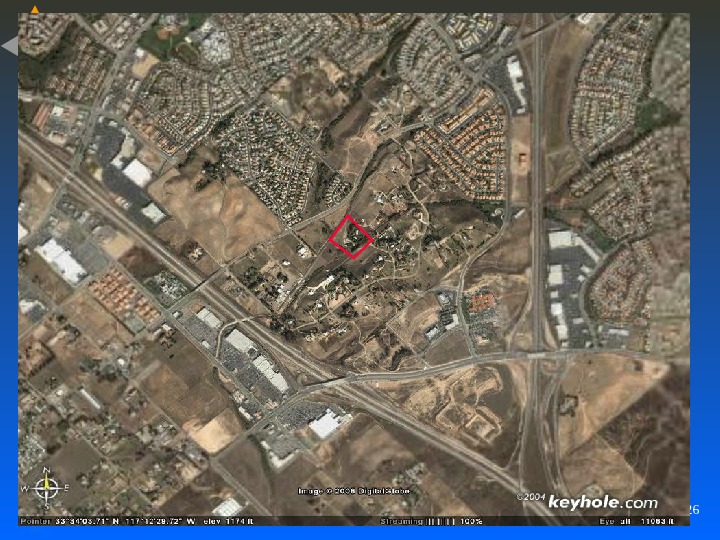

12-highest_and_best_use_decisions.ppt
- Размер: 406 Кб
- Количество слайдов: 27
Описание презентации 1 Highest and Best Use Decisions Wayne Foss, по слайдам
 1 Highest and Best Use Decisions Wayne Foss, DBA, MAI, CRE, FRICS Foss Consulting Group Email: wfoss@fossconsult. com
1 Highest and Best Use Decisions Wayne Foss, DBA, MAI, CRE, FRICS Foss Consulting Group Email: wfoss@fossconsult. com
 2 Highest and Best Use Definition: The reasonably probable and legal use of vacant land or an improved property, which is physically possible, appropriately supported, financially feasible, and that results in the highest value. The four criteria the highest and best use must meet are legal permissibility, physical possibility, financial feasibility, and maximum productivity. (The Dictionary of Real Estate Appraisal, 4 th ed. , pg. 135)
2 Highest and Best Use Definition: The reasonably probable and legal use of vacant land or an improved property, which is physically possible, appropriately supported, financially feasible, and that results in the highest value. The four criteria the highest and best use must meet are legal permissibility, physical possibility, financial feasibility, and maximum productivity. (The Dictionary of Real Estate Appraisal, 4 th ed. , pg. 135)
 3 Purpose of Highest and Best Use Market Analysis provides information on physical, legal and economic issues Analysis of alternative uses determines the Highest and Best Use Provides an economic basis for the use finally chosen by addressing: Utility Desire Scarcity Effective Purchasing Power
3 Purpose of Highest and Best Use Market Analysis provides information on physical, legal and economic issues Analysis of alternative uses determines the Highest and Best Use Provides an economic basis for the use finally chosen by addressing: Utility Desire Scarcity Effective Purchasing Power
 4 Purpose of Highest and Best Use for Real Estate Appraisals Establishes the criteria for selecting comparable sales Establishes the elements of comparison Provides the basis for estimates of physical, functional and external obsolescence Provides the basis forecasts required to apply the income capitalization approach Occupancy Timing (absorption) Amount (capture) Rents
4 Purpose of Highest and Best Use for Real Estate Appraisals Establishes the criteria for selecting comparable sales Establishes the elements of comparison Provides the basis for estimates of physical, functional and external obsolescence Provides the basis forecasts required to apply the income capitalization approach Occupancy Timing (absorption) Amount (capture) Rents
 5 Two Major Parts of a Valuation Appraisal 1. Basis for Value (Highest and Best Use) 2. Application of the Three Approaches Note: The thorough study of market forces that affect use and value requires study time at least equivalent to the study time afforded to measuring that value by applying the appropriate techniques and procedures of the valuation approaches.
5 Two Major Parts of a Valuation Appraisal 1. Basis for Value (Highest and Best Use) 2. Application of the Three Approaches Note: The thorough study of market forces that affect use and value requires study time at least equivalent to the study time afforded to measuring that value by applying the appropriate techniques and procedures of the valuation approaches.
 6 Application Vacant Land Improved Property Land as though vacant Property as improved Items Specified in Highest and Best Use Conclusions: Physical Use Time (probable use date or occupancy forecast) Market Participants Typical User of Space Most Probable type of buyer
6 Application Vacant Land Improved Property Land as though vacant Property as improved Items Specified in Highest and Best Use Conclusions: Physical Use Time (probable use date or occupancy forecast) Market Participants Typical User of Space Most Probable type of buyer
 7 Discussion Questions If the purpose of a highest and best use study is to establish the basis of value, are the following highest and best use conclusions adequate? Vacant Land: Develop for retail use when the demand warrants. Improved Property: Continue use as a multi-tenant office building. If the highest and best use statements are not adequate, what is missing? What misunderstandings may lead to inadequacies in the highest and best use conclusions?
7 Discussion Questions If the purpose of a highest and best use study is to establish the basis of value, are the following highest and best use conclusions adequate? Vacant Land: Develop for retail use when the demand warrants. Improved Property: Continue use as a multi-tenant office building. If the highest and best use statements are not adequate, what is missing? What misunderstandings may lead to inadequacies in the highest and best use conclusions?
 8 Land Use Alternatives Vacant Land Nature of Analysis consideration of probable alternative uses Extent of the Analysis Usually involves many highly competitive alternative uses. Requires the most detailed study (fundamental analysis).
8 Land Use Alternatives Vacant Land Nature of Analysis consideration of probable alternative uses Extent of the Analysis Usually involves many highly competitive alternative uses. Requires the most detailed study (fundamental analysis).
 9 Land Use Alternatives Land as though Vacant Nature of Analysis Improved property will continue in its current use until the land as vacant, less demolition cost, is more valuable that the property as improved. Extent of the Analysis If land value does not approach the value of the property as improved, a detailed study of alternative uses is less critical (inferred analysis).
9 Land Use Alternatives Land as though Vacant Nature of Analysis Improved property will continue in its current use until the land as vacant, less demolition cost, is more valuable that the property as improved. Extent of the Analysis If land value does not approach the value of the property as improved, a detailed study of alternative uses is less critical (inferred analysis).
 10 Land Use Alternatives Property As Improved Nature of Analysis If the improvements contribute to value such that the value of the improved property is equal to or greater than the value of the land as though vacant, the existing improvement(s) must be considered as contributing to the property’s current highest and best use. Extent of the Analysis How long and at what level (occupancy and rents) will the current improvements perform? (timing issue) How long will the current improvements contribute to the property value? (timing issue) Can the current improvements be remodeled, renovated or converted, or demolished in the future? If remodeling, renovation, conversion or demolition, what is the time frame?
10 Land Use Alternatives Property As Improved Nature of Analysis If the improvements contribute to value such that the value of the improved property is equal to or greater than the value of the land as though vacant, the existing improvement(s) must be considered as contributing to the property’s current highest and best use. Extent of the Analysis How long and at what level (occupancy and rents) will the current improvements perform? (timing issue) How long will the current improvements contribute to the property value? (timing issue) Can the current improvements be remodeled, renovated or converted, or demolished in the future? If remodeling, renovation, conversion or demolition, what is the time frame?
 11 Land Use Alternatives Proposed Properties Nature of the Analysis If the assignment is to value the property at a proposed use, a detailed marketability study of that use is required. Extent of the Analysis Even when new, the proposed improvement may not be the highest and best use of the land as though vacant. Alternative uses should be considered A detailed marketability study of each alternative use may be required (fundamental analysis)
11 Land Use Alternatives Proposed Properties Nature of the Analysis If the assignment is to value the property at a proposed use, a detailed marketability study of that use is required. Extent of the Analysis Even when new, the proposed improvement may not be the highest and best use of the land as though vacant. Alternative uses should be considered A detailed marketability study of each alternative use may be required (fundamental analysis)
 12 Testing Highest and Best Alternatives Criteria Physically Possible What uses can be constructed on the site? What alterations are physically possible? Legal Permissibility Existing restrictions as vacant Existing restrictions as improved Can existing restrictions be changed to allow more intense use? Will deed restrictions increase the property’s market appeal? What legal attributes give the subject a market advantage?
12 Testing Highest and Best Alternatives Criteria Physically Possible What uses can be constructed on the site? What alterations are physically possible? Legal Permissibility Existing restrictions as vacant Existing restrictions as improved Can existing restrictions be changed to allow more intense use? Will deed restrictions increase the property’s market appeal? What legal attributes give the subject a market advantage?
 13 Testing Highest and Best Alternatives Criteria, continued. . . Financial Feasibility Considering Risk and all costs to create and maintain the use — — What uses, as though vacant, produce a positive return to land? What uses, as improved, result in a positive present value? Maximum Productivity Which use results in the highest present value? For Vacant Land: ideal development specified in terms of density and style For Improved Property: the improvement remains as-is, is added to, is remodeled or renovated, converted to another use or demolished.
13 Testing Highest and Best Alternatives Criteria, continued. . . Financial Feasibility Considering Risk and all costs to create and maintain the use — — What uses, as though vacant, produce a positive return to land? What uses, as improved, result in a positive present value? Maximum Productivity Which use results in the highest present value? For Vacant Land: ideal development specified in terms of density and style For Improved Property: the improvement remains as-is, is added to, is remodeled or renovated, converted to another use or demolished.
 14 Reasonably Probable and Adequately Supported Aspects of Highest and Best Use Theory To select use alternatives that should be tested To judge the appropriateness of conclusions from the application of each of the highest and best use criteria Problem Determining reasonable probability and adequate support is left to the analyst’s judgment Initial Assessment Based on market acceptability Only practical to investigate alternative uses for land or improvements when a reasonable probability exists for potential alternative uses
14 Reasonably Probable and Adequately Supported Aspects of Highest and Best Use Theory To select use alternatives that should be tested To judge the appropriateness of conclusions from the application of each of the highest and best use criteria Problem Determining reasonable probability and adequate support is left to the analyst’s judgment Initial Assessment Based on market acceptability Only practical to investigate alternative uses for land or improvements when a reasonable probability exists for potential alternative uses
 15 Reasonably Probable and Adequately Supported Aspects of Highest and Best Use Zoning At times, it is mandatory to investigate the reasonable probability of a zone change. Relationship of Reasonable Probability and Adequate Support to the four highest and best use criteria Must address the reasonable probability of market acceptance and demand for the alternative use Adequate support for a reasonably probable, physically possible and legal use is the first issue addressed Must apply sound judgment!
15 Reasonably Probable and Adequately Supported Aspects of Highest and Best Use Zoning At times, it is mandatory to investigate the reasonable probability of a zone change. Relationship of Reasonable Probability and Adequate Support to the four highest and best use criteria Must address the reasonable probability of market acceptance and demand for the alternative use Adequate support for a reasonably probable, physically possible and legal use is the first issue addressed Must apply sound judgment!
 16 Test the Performance of a Property Use: Information and Measures Physical Possibility determined by analysis of the property itself Items considered in testing Site characteristics Existing improvement characteristics
16 Test the Performance of a Property Use: Information and Measures Physical Possibility determined by analysis of the property itself Items considered in testing Site characteristics Existing improvement characteristics
 17 Test the Performance of a Property Use: Information and Measures Legal Permissibility determined by analysis of the public and private restrictions Items considered in testing Current zoning and other land use restrictions Building Codes Private restrictions Probability of modification or change of current restrictions (public and private)
17 Test the Performance of a Property Use: Information and Measures Legal Permissibility determined by analysis of the public and private restrictions Items considered in testing Current zoning and other land use restrictions Building Codes Private restrictions Probability of modification or change of current restrictions (public and private)
 18 Rate Factors for Possible Zone Change. Factors 123 1. The site is not physically suitable for the use currently allowed by zoning, but is physically suitable for the land development forecasted for the subject. 2. The use forecast for the subject is comparable or can be designed to be compatible with adjacent land uses. 3. The forecasted probable use of the subject conforms to the city’s comprehensive plan. 4. Conditions in the subject area have changed since the date the current zoning for the subject became active. 5. A public good can be shown for the use of the subject property. 6. There is a history of approved zoning changes to similar properties in similar locations in other parts of town. 7. No nearby neighborhood association is known to oppose similar zoning change requests that would accommodate the forecast use for the subject. Alternatives Analysis of Alternative Uses Considering the Possibility of a Zoning Change
18 Rate Factors for Possible Zone Change. Factors 123 1. The site is not physically suitable for the use currently allowed by zoning, but is physically suitable for the land development forecasted for the subject. 2. The use forecast for the subject is comparable or can be designed to be compatible with adjacent land uses. 3. The forecasted probable use of the subject conforms to the city’s comprehensive plan. 4. Conditions in the subject area have changed since the date the current zoning for the subject became active. 5. A public good can be shown for the use of the subject property. 6. There is a history of approved zoning changes to similar properties in similar locations in other parts of town. 7. No nearby neighborhood association is known to oppose similar zoning change requests that would accommodate the forecast use for the subject. Alternatives Analysis of Alternative Uses Considering the Possibility of a Zoning Change
 19 Test the Performance of a Property Use: Information and Measures Financial Feasibility Establishing adequate support for a use detailed marketability study is needed Cost of Alternative Uses Development Costs Land acquisition and site development Costs of obtaining necessary approvals and permits Building Costs Construction and Indirects Entrepreneurial incentive Holding Costs Operating expenses Comparison of alternative Uses
19 Test the Performance of a Property Use: Information and Measures Financial Feasibility Establishing adequate support for a use detailed marketability study is needed Cost of Alternative Uses Development Costs Land acquisition and site development Costs of obtaining necessary approvals and permits Building Costs Construction and Indirects Entrepreneurial incentive Holding Costs Operating expenses Comparison of alternative Uses
 20 Test the Performance of a Property Use: Information and Measures Maximum Productivity The financially feasible use that results in the highest present value Confidence in the conclusion may require a form of reconciliation
20 Test the Performance of a Property Use: Information and Measures Maximum Productivity The financially feasible use that results in the highest present value Confidence in the conclusion may require a form of reconciliation
 21 Consideration of Alternative Uses Vacant Land property productivity analysis (site, improvements, legal, and location attributes) usually eliminates most alternatives Improved Properties If the property at its current use is forecast to lease up or stay leased up that insures a value at or above the values of the other alternatives — no further analysis is needed. Current use is selected as highest and best use.
21 Consideration of Alternative Uses Vacant Land property productivity analysis (site, improvements, legal, and location attributes) usually eliminates most alternatives Improved Properties If the property at its current use is forecast to lease up or stay leased up that insures a value at or above the values of the other alternatives — no further analysis is needed. Current use is selected as highest and best use.
 22 Consideration of Alternative Uses Demolition Alternative If the value of the property in its current use is significantly higher than the value of the land as though vacant, the demolition alternative is eliminated from further study. Interim and/or Alternative Use of Improvements must consider alternative uses or the timing for demolition of existing improvements Vacant buildings or Properties operating with extremely low or negative NOI alternative uses or alternative operation of the current improvements should be considered in detail
22 Consideration of Alternative Uses Demolition Alternative If the value of the property in its current use is significantly higher than the value of the land as though vacant, the demolition alternative is eliminated from further study. Interim and/or Alternative Use of Improvements must consider alternative uses or the timing for demolition of existing improvements Vacant buildings or Properties operating with extremely low or negative NOI alternative uses or alternative operation of the current improvements should be considered in detail
 23 Mathematical Procedures Selecting and financial decision model Three characteristics must be realized by the model 1. The model must consider the amount and timing of all cash flows. 2. The model must consider the time value of money. 3. The model must consistently select the use that will produce the highest financial reward.
23 Mathematical Procedures Selecting and financial decision model Three characteristics must be realized by the model 1. The model must consider the amount and timing of all cash flows. 2. The model must consider the time value of money. 3. The model must consistently select the use that will produce the highest financial reward.
 24 Mathematical Procedures Vacant land as though vacant Current financial feasibility is not a requirement Use must eventually be financially feasible to be considered Feasibility Rent is the tool for determining financial feasibility Feasibility rent is the rent necessary to justify new construction If market rent is at or above feasibility rent, construction is justified If market rent is less than feasibility rent, financial feasibility can only be achieved if market rent is growing faster than expenses and costs.
24 Mathematical Procedures Vacant land as though vacant Current financial feasibility is not a requirement Use must eventually be financially feasible to be considered Feasibility Rent is the tool for determining financial feasibility Feasibility rent is the rent necessary to justify new construction If market rent is at or above feasibility rent, construction is justified If market rent is less than feasibility rent, financial feasibility can only be achieved if market rent is growing faster than expenses and costs.
 25 Mathematical Procedures Improved Property Current financial feasibility is a requirement Requires that the property value as-is must be surpassed by the value of the property after conversion, renovation or alteration (CRA) less the costs of CRA. Alteration can result from excess or surplus land Alteration can mean demolition of improvements
25 Mathematical Procedures Improved Property Current financial feasibility is a requirement Requires that the property value as-is must be surpassed by the value of the property after conversion, renovation or alteration (CRA) less the costs of CRA. Alteration can result from excess or surplus land Alteration can mean demolition of improvements

 27 So That’s Highest and Best Use Decisions Wayne Foss, DBA, MAI, CRE, FRICS, Fullerton, CA USA Email: waynefoss@usa. net
27 So That’s Highest and Best Use Decisions Wayne Foss, DBA, MAI, CRE, FRICS, Fullerton, CA USA Email: waynefoss@usa. net

